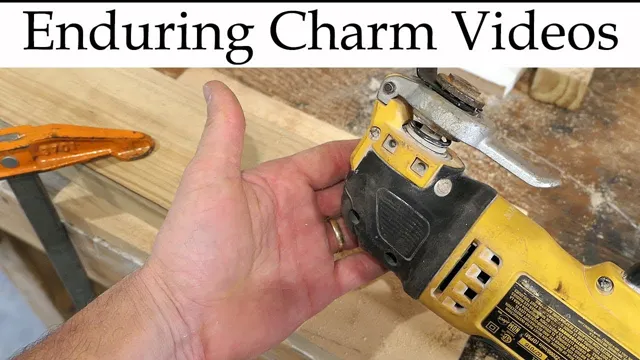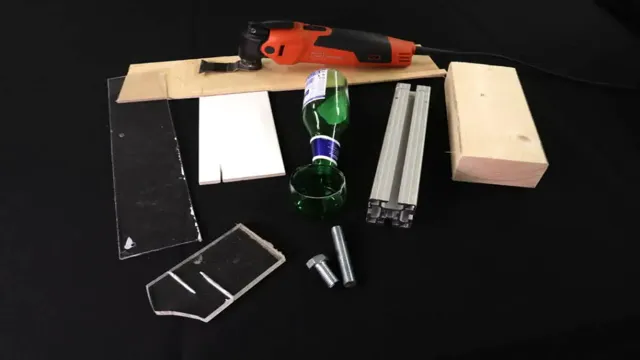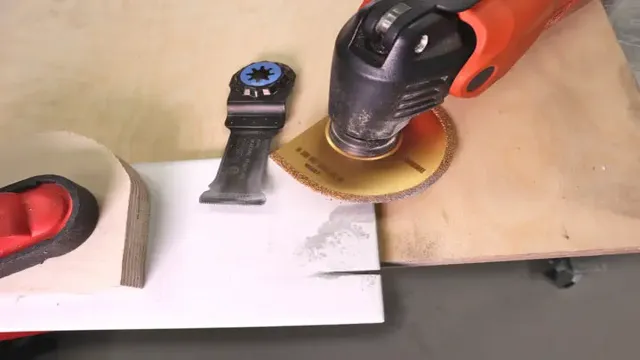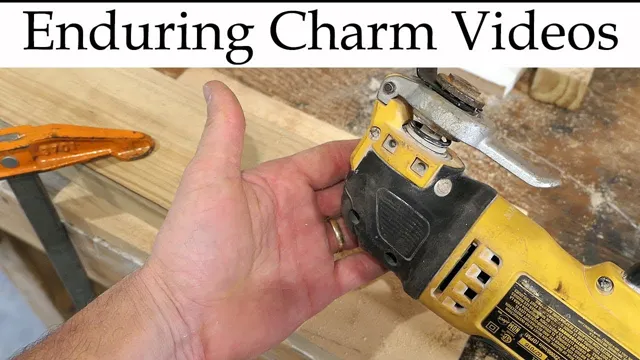How Does an Oscillating Multi Tool Work: A Comprehensive Guide
Have you ever wondered how an oscillating multi-tool works and why it is considered a must-have tool for DIY enthusiasts and professionals alike? It’s a versatile tool that can be used for a wide range of applications, from sanding and scraping to cutting and grinding. This tool’s secret lies in its oscillating blade which is capable of making quick back and forth movements at high speeds. These vibrations easily cut through many different kinds of materials, making it a dependable tool for both commercial and personal use.
In this blog post, we’ll explore how an oscillating multi-tool works and why it should be included in your tool kit.
Introduction
Have you ever wondered how an oscillating multi-tool works? Well, it’s pretty simple actually. This tool operates by moving a blade or sanding pad back and forth in high frequency. This oscillating motion creates a cutting or sanding action at a fast speed, making this tool perfect for a variety of DIY projects.
The multi-tool can be used for cutting a range of materials such as wood, metal, or plastic, and can also sand surfaces in a flash. The oscillations are powered by a motor, which is typically controlled by a trigger switch. As you press and hold the trigger, the blade or sanding pad will continue to oscillate back and forth until released.
With its versatility and ease-of-use, the oscillating multi-tool is a must-have for any DIY enthusiast or professional handyman.
Overview of Oscillating Multi Tool
If you’re a DIY enthusiast, a contractor, or just someone in need of a versatile power tool, then an oscillating multi tool might just be the tool for you. An oscillating multi tool, also known as an oscillating tool, is a handheld power tool that delivers high-speed oscillating movement to a flat or curved blade. This makes it ideal for cutting, grinding, sanding, scraping, and polishing a wide range of materials such as wood, metal, plastics, and ceramics.
Due to its compact and lightweight design, an oscillating multi tool is perfect for tackling jobs in tight spaces that other tools can’t reach. Whether you’re a professional contractor or just a DIY enthusiast, an oscillating multi tool can provide you with a versatile, portable solution for all your cutting, grinding, sanding, and scraping needs.
Components of Oscillating Multi Tool
An oscillating multi tool is a versatile power tool that can tackle a variety of tasks. But how does an oscillating multi tool work? The key to its functionality lies in its components. First, the oscillating motor creates a back-and-forth motion, which is then transferred to the tool head.
The tool head is where the magic happens – it can be equipped with various attachments, such as sanding pads, cutting blades, and scrapers, depending on the task at hand. The speed and intensity of the motion can be adjusted by the user, allowing for precise and controlled cutting, sanding, and scraping. Additionally, oscillating multi tools often come with a dust port, which can help to keep your work area clean.
With its unique design and powerful components, an oscillating multi tool is a valuable addition to any DIY arsenal.
Motor
One of the crucial components of an oscillating multi tool is its motor. The motor is the driving force behind the oscillation of the tool tip, which makes it possible for the tool to cut and sand materials. A good motor is characterized by its power and efficiency.
Most multi tools have motors with varying power ranges, which determine their speed and cutting strength. The more powerful the motor, the faster and smoother the cutting process. When choosing a multi tool, it’s essential to consider the type and power of the motor, as it directly affects the quality of work you can produce.
A good analogy is that the motor is like the heart of the multi tool, and the quality of your work is directly proportional to the strength and efficiency of the motor. So, ensure you choose a multi tool with a robust motor to get the best results.
Oscillation Angle
The oscillation angle is an important component of an oscillating multi-tool that determines the amount of vibration produced during operation. The angle, measured in degrees, refers to the range of motion of the tool’s blade or sanding pad. The wider the oscillation angle, the greater the depth of cut or material removal and the faster the sanding.
However, a wider angle can also result in a rougher finish and a more aggressive cut. On the other hand, a smaller oscillation angle provides a smoother finish but may take longer to remove material. It’s important to consider the specific task at hand when selecting the appropriate oscillation angle for your oscillating multi-tool to achieve the desired result.
Blades and Accessories
When it comes to an oscillating multi tool, there are several components that come together to make it a versatile and handy tool. One of the most important aspects of an oscillating multi tool is its blades. These are available in various shapes and sizes and can be easily interchanged to handle different types of cutting, sanding, and grinding tasks.
Another essential component is the accessories, which can include sanding pads, scrapers, and plunge-cut blades. These add-ons can help you tackle a wide range of projects with ease, whether you’re cutting wood or metal, sanding surfaces, or removing grout. Additionally, some models come with speed control options, which allow you to adjust the oscillation rate based on your specific needs.
This ensures greater precision and control, making it easier to achieve a clean and accurate result. Ultimately, the combination of blades, accessories, and speed control features makes an oscillating multi tool an indispensable tool for DIY enthusiasts and professionals alike, capable of handling a vast range of tasks with ease and efficiency. So, if you’re looking for a versatile and reliable tool to add to your collection, an oscillating multi tool is definitely worth considering.
Operating an Oscillating Multi Tool
Oscillating multi tools are becoming increasingly popular in the world of DIY; they are compact, versatile and can help you complete a variety of tasks around the house. But how does an oscillating multi tool work? Essentially, these tools use a high-speed motor to generate oscillations or vibrations. The tool’s blade or accessory is attached to the motor shaft, and the oscillating motion helps to transfer energy to the blade, allowing it to cut, sand, grind or scrape.
The tool’s design means that it can work in tight spaces and corners that traditional power tools find difficult to reach. Oscillating multi tools can also be adjusted to operate at different angles and speeds, making them perfect for precision work. One of the benefits of using an oscillating multi tool is that it can quickly change attachments, allowing you to switch from cutting to sanding in seconds.
They are perfect for a variety of tasks around the home, making them a must-have for any DIY enthusiast.
Power Source
When it comes to operating an oscillating multi tool, understanding the power source is essential. These versatile tools can be powered by electricity or batteries, and each option has its pros and cons. Electric tools provide consistent power and are generally more powerful than battery-operated ones.
However, they are limited by the length of the cord, so you may need an extension cord to reach your work area. On the other hand, battery-operated tools are more portable and do not have any cord limitations. However, the power output may be lower, and the battery may need to be recharged frequently, slowing down your work process.
Therefore, it’s important to choose the power source based on your specific needs and the nature of your project. Consider the duration of the task, the location, and the amount of power required. Ultimately, choosing the right power source will ensure efficient and effective use of your oscillating multi tool.
Blade and Accessory Changes
When it comes to operating an oscillating multi tool, one of the most critical aspects is knowing how to change blades and accessories correctly. Failure to do so can result in damage to the tool itself, as well as poor cutting performance, making the job at hand more difficult. Before starting, it’s essential to ensure that the tool is completely powered down, and the battery (if applicable) has been removed.
Next, refer to the user manual to familiarize yourself with the process, as each brand and model can vary in how blades and accessories are swapped. Some may require a specialized tool, while others can be changed with a simple flick of a button. Remember to always wear protective gloves during this process, as blades and accessories can be incredibly sharp.
Overall, taking the time to learn the correct way to change blades and accessories will not only help you maintain your oscillating tool’s longevity but also ensure optimal cutting performance on your next project.
Using the Multi Tool
Operating an oscillating multi tool can be a daunting task, especially if you are new to this innovative tool. However, with a little practice and patience, you can become a pro in no time. The first step in using a multi tool is to select the proper blade or accessory for the job you want to perform.
Once you have chosen the correct tool, it’s time to clamp it into place tightly. The next step is to turn on the tool and adjust the speed to the desired setting. It’s important to start slow and gradually increase the speed until you reach the desired level.
Remember to hold the tool firmly and at a comfortable angle while in use. Oscillating multi tools are perfect for precise cuts and sanding in hard-to-reach places. With a little practice, you can become proficient in using a multi tool and complete your projects with ease.
Applications of Oscillating Multi Tool
An oscillating multi tool works by utilizing the back-and-forth movement of its blade or attachment to make precise cuts or sanding motions in a variety of materials. The tool can accomplish a wide range of tasks, including cutting through tile and drywall, trimming door jambs and baseboards, sanding and shaping wood, and even removing grout. The key to its versatility lies in its ability to accept a variety of attachments, allowing the user to quickly and easily switch between tasks.
Oscillating multi tools can be powered by electricity or battery, with cordless options offering greater convenience and flexibility on the job site. Whether you are a professional contractor or a DIY enthusiast, an oscillating multi tool can be an invaluable addition to your tool collection.
DIY Projects
As a DIY enthusiast or homeowner, an oscillating multi tool can come in handy for a variety of projects. Whether you’re looking to make precise cuts, sand tight spaces, or remove grout, an oscillating tool can make short work of these tasks. One application of an oscillating tool is cutting through a variety of materials, including wood, metal, and plastic, with ease.
The blade on the oscillating tool rapidly oscillates back and forth, giving you greater control and precision compared to traditional saws. Another handy application is sanding tight and hard-to-reach areas, such as corners or edges, where other power sanders may not be able to reach. The oscillating tool’s triangular sanding pad can make quick work of these spots.
Additionally, oscillating tools are great for removing grout or caulk. With a grout removal blade attached, the oscillating tool can make quick work of removing old grout in a bathroom or kitchen. Overall, an oscillating multi tool is a versatile and valuable addition to any DIYer’s tool collection.
Professional Use
One of the most versatile tools in the professional tool kit is the oscillating multi tool. Used by contractors, builders, and DIY enthusiasts, this tool is capable of performing a wide variety of tasks with ease. One popular application for the oscillating multi tool is in the field of flooring.
This tool can be used to cut through hardwood, tile, or vinyl with precision and speed, making quick work of any flooring project. Another useful application is in plumbing projects, where the tool can be used to cut through pipes or make precision cuts in drywall for access to plumbing fixtures. Additionally, the oscillating multi tool is excellent for sanding, polishing, and even grout removal.
With so many uses, it’s easy to see why the oscillating multi tool is a must-have for any professional toolkit.
Conclusion
In conclusion, an oscillating multi-tool works like the ultimate superhero of power tools. It uses a combination of speed, precision, and versatility to tackle any task at hand. Think of it like a ninja sword, but instead of slicing through enemies, it slices through materials.
With its oscillating action, it can cut, sand, grind, and scrape with ease, making it a handy tool for both professional and DIY enthusiasts. So next time you need to unleash your inner handyman/woman, turn to the oscillating multi-tool, and say goodbye to the days of struggling with multiple tools. It’s time to let the oscillating multi-tool do the work like a boss!
FAQs
What is an oscillating multi tool?
An oscillating multi tool is a power tool that is designed to perform a wide range of cutting, sanding, grinding, and scraping tasks.
How does an oscillating multi tool work?
An oscillating multi tool works by oscillating a blade or attachment back and forth at high speeds. This motion allows the tool to make precise cuts and perform a variety of tasks.
What types of blades or attachments can be used with an oscillating multi tool?
An oscillating multi tool can use a variety of blades and attachments, including cutting blades, sanding pads, grinding attachments, and scraping blades.
What materials can be cut with an oscillating multi tool?
An oscillating multi tool can cut a variety of materials, including wood, plastic, metal, drywall, and more.
How does the speed control on an oscillating multi tool work?
The speed control on an oscillating multi tool allows the user to adjust the speed of the tool to match the task at hand. This is typically done through a dial or switch on the tool.
What safety precautions should be taken when using an oscillating multi tool?
When using an oscillating multi tool, it is important to wear protective gear such as eye protection and gloves, and to be aware of the tool’s sharp blades and high speeds.
Can an oscillating multi tool be used for detailed work?
Yes, an oscillating multi tool is ideal for detailed work thanks to its ability to make precise cuts and perform a variety of tasks with different blades and attachments.




